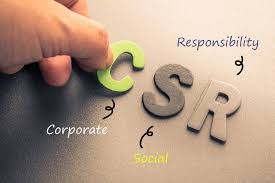References:
[1]. Adegbola, E. A. (2014). Corporate social responsibility as a marketing strategy for enhanced performance in the Nigerian banking industry: A granger causality approach. Procedia-Social and Behavioral Sciences, 164, 141-149.
[2]. Aguilera, R. V., Rupp, D. E., Williams, C. A., & Ganapathi, J. (2007). Putting the S back in corporate social responsibility: A multilevel theory of social change in organizations. Academy of management review, 32(3), 836-863.
[3]. Ahmad, A. & Jaseem, S. (2006). From principles to practise: Exploring corporate social responsibility in Pakistan. http://www.highbeam.com/doc/1G1-160417519.html (accessed 21 January 2017).
[4]. Akanbi, P. A., & Ofoegbu, O. E. (2012). Impact of corporate social responsibility on bank performance in Nigeria. Journal of US-China Public Administration, 9(4), 374-383.
[5]. Armstrong, G. & Kotler, P. (2008). Marketing: An introduction. New Jersey: Pearson.
[6]. BSR. (2006). “Introduction to corporate social responsibility”,
http://www.bsr.org/resourcecentre/topic Access Date: 1st March, 2017.
[8]. Burke, L., & Logsdon, J. (1996). How Corporate Social Responsibility Pays. Long Range Planning, 29(4), 495-502.
[9]. Carroll, A. B. (2008). A history of corporate social responsibility: Concepts and practices. The Oxford handbook of corporate social responsibility, 19-46.
[10]. Dahlsrud, A. (2008). How corporate social responsibility is defined: an analysis of 37.
[11]. European Union (2006). Green Paper on Promoting a European Framework for Corporate Social Responsibility. Luxembourg: European Commission http://www.ilo.org/wcmsp5/groups/public/---dgreports/---integration/ documents/publication/wcms_079130.pd. Accessed: 1st October 2016.
[12]. Freeman, I., & Hasnaoui, A. (2011). The meaning of corporate social responsibility: The vision of four nations. Journal of Business Ethics, 100(3), 419-443.
[13]. Freeman, R. E. (1984). Strategic Management: A Stakeholder Perspective, (3rd ed.) Englewood.
[14]. Garriga, E., & Mele, D. (2004) Corporate social responsibility theories: Mapping and territory. Journal of Business Ethics, 53(1), 51-74.
[15]. Gautam, T., (2013). Organizational identification and organizational commitment: Distinct aspects of two related concepts. Asian Journal of Social Psychology, 7, 301-315.
[16]. Grayson, D., & Hodges, A. (2017). Corporate social opportunity! Seven steps to make corporate social responsibility work for your business. Routledge.
[17]. Gudjansdottir, N., & Jusubova, A. (2015). Corporate social responsibility effects on brand image: Commitment to the Organization. Journal of Occupational, 7(5), 65-78.
[18]. Gudjonsdottir, E. & Jusubova, A. (2015). CSR’s effect on brand image Unpublished Bachelor Project. Kristianstad University.
[19]. Hair, J. F., Sarstedt, M., Ringle, C. M., & Mena, J. A. (2014). An assessment of the use of partial least squares structural equation modelling in marketing research. Journal of the Academy of Marketing Science, 40, 414-433.
[20]. Hill, I. (2006). “How Finance Can Help Move CSR up the Agenda”, The Cost and Management, 34(6), 5–9.
[21]. Hopkins, M. (2007). Corporate Social Responsibility: An Issues Paper”. Working Paper No. 27, World Commission for Social Dimension of Globalization, ILO, Geneva. Available from
http://www.ilo.org/wcmsp5/groups/public/---dgreports/---integration/ documents/publication/wcms_079130.pdf. Accessed: 1st October 2016.
http://www.EzineArticles.com Accessed: 1st October 2016.
[22]. Husted, B. & Allen, A. D. (2007). Strategic Corporate Social Responsibility and Value Creation Among Large Firms: Lessons from the Spanish Experience. Long Range Planning, 40(1), 594–610.
[23]. Johnson, H. (2003). Does It Pay to Be Good? Social Responsibility and Financial Performance. Business Horizons, 46, November-December, 34-40.
[24]. Kelloway, E. K. (1998) Using LISREL for structure equation modelling: A researcher’s guide, Newbury Park, CA: Sage.
[25]. Kitchin, T. (2003). Corporate social responsibility: A brand explanation. Journal of Brand Management, 4(5), 312-330.
[26]. Krejcie, R. V., & Morgan, D. W. (1970). Determining sample size for research activities. Educational and psychological measurement, 1(30), 607-610.
[27]. Lantos, G. P. (2001), “The ethicality of altruistic corporate social responsibility”, Journal of Consumer Marketing, 19(3), 205-230.
[28]. Lins, K. V., Servaes, H., & Tamayo, A. (2017). Social capital, trust, and firm performance: The value of corporate social responsibility during the financial crisis. The Journal of Finance, 72(4), 1785-1824.
[29]. Marin, L., & Lindgreen, A. (2017). Marketing and Corporate Social Responsibility and Agenda for Future Research. Spanish Journal of Marketing, 21(1), 1-3.
[30]. McWilliams, A. & Siegel, D. (2001). Corporate social responsibility and financial performance: correlation or misspecification?”. Strategic Management. Journal. 21(5), 603–609.
[31]. McWilliams, A. & Siegel, D. (2001). Corporate social responsibility: A theory of the firm perspective. Academy of Management Review, 26(1), 117-127.
[32]. Minor, D & Morgan, J. (2011). CSR as reputation insurance, California Management Review 53(3), 40-59.
[33]. Muchiri, R. M. (2013). Effects of Corporate Social Responsibility on Brands Performance in The Banking Industry: A Case Study of Family Bank Kenya Limited. Unpublished Thesis, School of Business, The University of Nairobi.
[34]. Nwakanma, C.I., & Emerole, G.A. (2017). Corporate social responsibility and corporate reputation: A study of Dufil Prima Foods Limited, Port Harcourt, Nigeria. International Journal of Social Sciences and Management Research, 1(4), 46-55.
[35]. Porter, M. E. & Kramer, M. R. (2006). The competitive advantage of corporate philanthropy. Harvard Business Review, 80 (12), 56-68.
[36]. Quazi, A. M., & O’Brien, D. (2000). An empirical test of a cross-national model of corporate Social responsibility. Journal of Business Ethics 25(1), 33-51.
[37]. Schwartz, M. S., & Carroll, A. B. (2008). Integrating and unifying competing and complementary frameworks: The search for a common core in the business and society field. Business & Society, 47(2), 148-186.
[38]. Schwartz, M. S., & Carroll, A. B. (2016). Corporate social responsibility: A three domain approach in: A. Crane/D. Matten/LJ Spence (Ed.), Corporate Social Responsibility. Readings and Cases in a Global Context.
[39]. Smith, I. (2004). Human resource development measuring return on investment. Library Management, 25(6), 318-20.
[40]. Solomon, A.Z., Oyerogba, E.O & Olaleye, M.O (2014) Effects of corporate social responsibility performance (CSR) on stock prices: Empirical study of listed manufacturing companies in Nigeria. IOSR Journal of Business and Management (IOSR-JBM). 16(8) 112-117.
[41]. Sweeney, L. (2009) A Study of Current Practise of Corporate Social Responsibility (CSR) and an Examination of the Relationship between CSR and Financial Performance Using Structural Equation Modelling (SEM). (Doctoral Thesis, Dublin Institute of Technology, Dublin).


